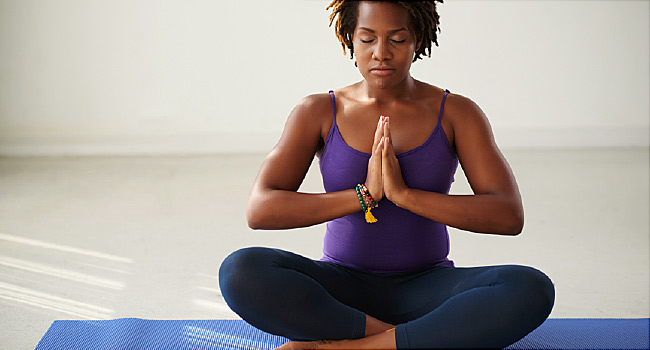‘Adaptive’ Yoga Opens This Practice to Everyone
Feb. 17, 2021 — The typical yoga class might look like a roomful of people bending and twisting themselves into various positions, but yoga is more than a series of pretzel-like poses. It’s a whole-body practice that uses movement, deep breathing, and relaxation.
You don’t have to be athletic, or even very mobile, to benefit. “If you can breathe, you can practice yoga,” says Carol Krucoff, a certified yoga therapist at Duke Integrative Medicine.
But a variation, called adaptive yoga, is designed to open up the practice to everyone — including people with movement-limiting conditions like multiple sclerosis, arthritis, or spinal cord injuries.
What Is Adaptive Yoga?
Instead of trying to force your body into one-size-fits-all poses, adaptive yoga fits the movements to what you’re able to do. It uses props like blankets, straps, and chairs to make the poses open to more people, and it recognizes that poses aren’t everything.
“Yoga is a journey inward to connect with your deepest, truest self,” says Krucoff. “Poses are a very important part of the practice, but they’re only one piece of the practice. It’s not just what you do in a yoga practice, but how you do it that matters.”
Matthew Sanford, a yoga teacher, author, and founder of the nonprofit organization Mind Body Solutions, has students who are quadriplegic. “They can’t move their limbs, but they still get a lot out of it,” he says.
Rather than work through a series of standard yoga moves, Sanford has his students get to the heart of each pose and move “from the inside out.”
“We try to help the yoga student see the way it really works, without it being dependent on achieving the outside-looking pose,” he says. For example, “If I sit down through my sitting bones, lift up through my chest, broaden across my shoulders, and take a breath, I have what would happen in a standing pose.”
Mind-Body Connection
For Sanford, who was paralyzed from the chest down in a car accident at age 13, practicing yoga has been life-changing. “I have more sensation than I knew was possible,” he says.
Adaptive yoga has helped him form a deeper sense of connection with his body. “It has helped me pay attention to the parts of my mind-body relationship that I normally wouldn’t have,” he says. He likens it to someone who has lost sight getting a keener sense of taste, smell, and touch. “The benefits are much more holistic and deeper than a physical practice.”
Adaptive yoga has practical health benefits as well. It can make you stronger and more flexible, improve your balance, and help with fatigue. Its deep breathing helps you relax.
The practice is also good for easing rigid muscles from conditions like MS and Parkinson’s disease. “Our students tell me, number one, that when they leave the yoga class, they’re moving better,” says Mindy Eisenberg, a yoga therapist who teaches people with MS and Parkinson’s.
Yoga fosters a sense of independence, too. Anybody — no matter what their ability level — can do it for themselves. “That is empowerment,” she says.
Adapting Your Practice
“Many yoga classes are taught like an exercise class, where you’ve got to keep up with the teacher. This is not appropriate for older adults and for people with health conditions,” says Krucoff, who co-authored the book Relax Into Yoga for Seniors and teaches yoga to older adults.
Her students have medical conditions, including osteoporosis, arthritis, and heart disease, that would make it hard for them to safely follow a traditional yoga class.
Adaptive yoga classes meet people where they are. Eisenberg adjusts her program to suit each of her students’ unique needs.
“Ideally, we meet with them before we go into a group class and we develop a plan for them,” says Eisenberg, who is also founder and director of Yoga Moves MS, and author of Adaptive Moves Yoga Any Body.
Some seemingly simple yoga poses can be hard for people with chronic conditions. For example, a standing forward bend with straight legs puts strain on the back, which isn’t good for those with back pain. To get the same stretch, Krucoff has her students lie on their back and bend one or both of their knees into their chest.
Downward-Facing Dog, where you place your hands and feet in a V shape on the floor, centers much of your body weight on your shoulders and wrists. The pressure can be too much if you have arthritis, shoulder injuries, or osteoporosis. “Instead of putting your hands on the floor, you might put your hands on the wall and walk back,” suggests Krucoff. You can modify a plank, which is also hard on the wrists, by putting your knees on the floor.
Add Props
Adaptive yoga uses a number of props, including a chair, blanket, strap, or block, to help you move into and hold poses. A blanket or folded towel under your neck keeps your head in the proper alignment when you lie on your back. Rolled up and placed under your knees, it supports your back.
A strap is useful for pulling your leg toward your body for a deeper stretch. Blocks are helpful when you can’t reach your hand all the way to the mat.
A chair keeps you steady when you stand up from a seated or lying position. It can also come in handy when you move into positions that involve balance, like Tree Pose, where you’d normally stand on one leg with the other foot pressed to your inner thigh. Eisenberg has her students instead sit in a chair and place one foot on their opposite ankle, shin or inner thigh. The bent knee may also rest on a second chair or the foot may placed on a few blocks for “Baby Bush”. Tree Pose can also be practiced lying on the ground.
Props don’t need to be fancy, or expensive, Krucoff says. “Just use what you’ve got in your house.” The belt of a robe or a scarf works as a strap, while a book makes a perfectly acceptable yoga block.
Where to Find a Class
Adaptive yoga is typically taught in small groups. Some classes are designed for people with a single condition, such as MS, breast cancer, or Parkinson’s disease.
Another option is to practice one-on-one with a yoga therapist who is specially trained to work with people who have medical conditions. The International Association of Yoga Therapists offers a directory to help you find a yoga therapist near you.
Some elements of yoga don’t require a class at all. “These are everyday movements,” Eisenberg says. You can do Mountain Pose anywhere. Simply stand, stacking your shoulders over hips, and head above shoulders, feet parallel and approximately hip distance apart, and arms down at your sides with palms open.up straight with your feet together and your arms down at your sides. She also stresses the importance of practicing deep breathing, which is the essence of yoga or to relax the nervous system.
How to Pay
Cost can be a big issue if you’re on a fixed income. Medicare and private insurance often won’t pay for adaptive yoga classes, unless your coverage includes membership to a gym that offers it.
Eisenberg says yoga therapists charge around $100 for a private session. Group classes are often less expensive. Some studios try to make their classes open to everyone by asking for a suggested donation, which for Eisenberg’s program is $10 per class.
Getting Started
Whenever you consider any new exercise routine, start by taking stock of your health, especially if you have a chronic condition. Ask your doctor whether yoga is safe for you.
Also make sure that your yoga teacher has been well-trained. Ideally, the person should have experience working with people who have the same condition as you, Krucoff says. She stresses the importance of finding a teacher who will respect your abilities, rather than expecting you to mimic their moves.
Throughout your practice, listen to your body and honor what you’re feeling. Modify poses as needed. And never push yourself to the point where it hurts, says Eisenberg.



